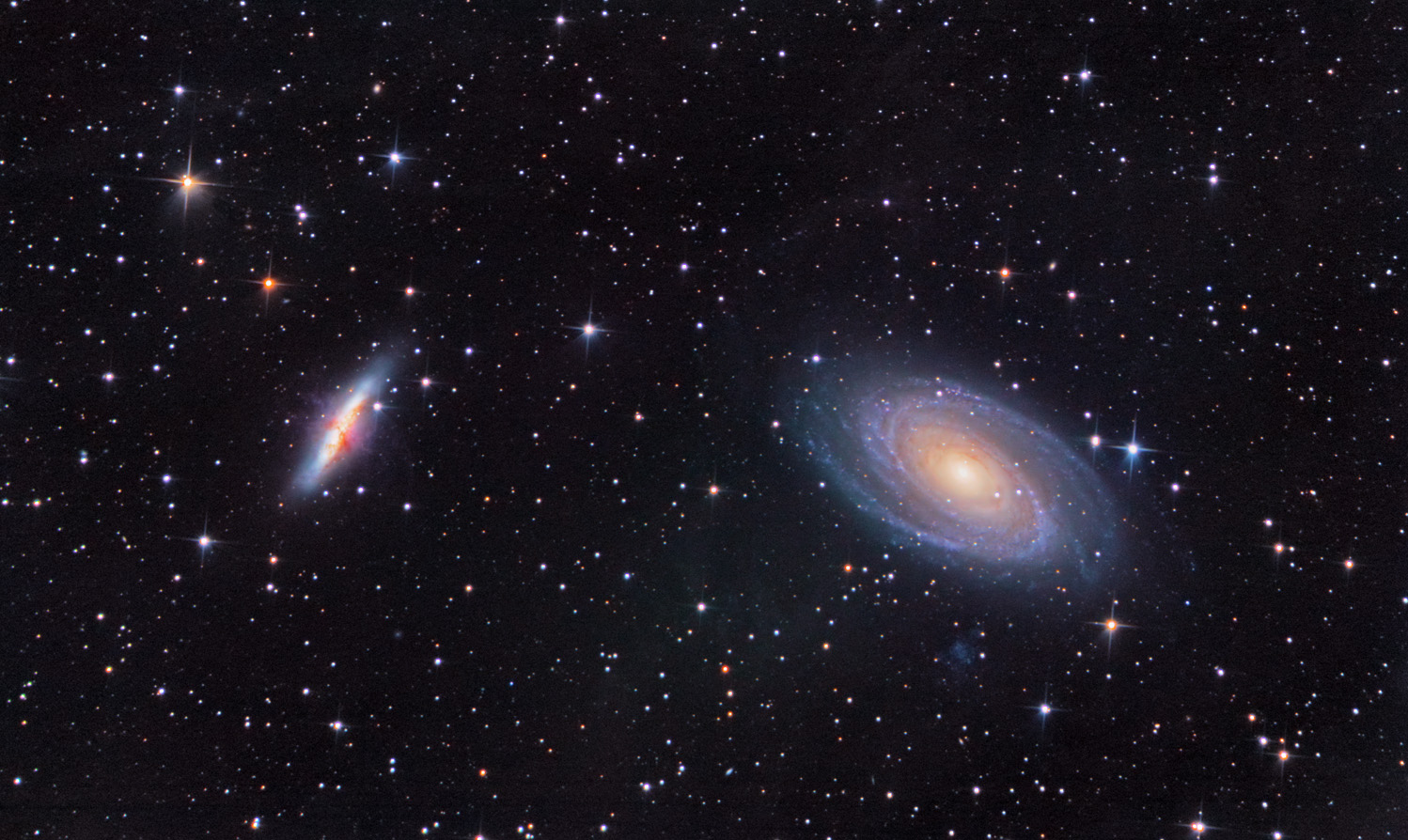
M82 (left) and M81 (right; also known as Bode's Galaxy)
Jared Bowens / S&T Online Photo Gallery
This was going to be the year I finally did some galaxy hunting — other than Andromeda (M31). I had plans, y’all.
For months, I dreamed of settling outside on clear nights in March, April, and into May, and zipping through a GoTo alignment before slewing around to new-to-me fuzzy dots in the sky.
Part of stargazing’s allure is the idea that I’m turning my attention to other worlds — at least to the suns illuminating those distant planets. When it comes to galaxies, each blurry smudge in my eyepiece has the potential host to tens of billions of planetary systems.
But I also have to be realistic. I don’t have a light-bucket Dobsonian or wide-aperture SCT in my telescope arsenal, but I did recently purchase a NexStar 127SLT from my astronomy club’s library. Not true galaxy quest equipment, but the 127SLT — nicknamed “Nichelle,” in honor of the late Nichelle Nichols — is the biggest telescope I can reliably set up and maneuver.
My expectations weren’t high. Nichelle is a small scope with a narrow field of view. I’m also in a Bortle class 6 zone in the suburbs close to a big city. I was prepared for disappointment.
Determined to make the best of it, however, I bookmarked articles and flipped through astronomy guides to compile my list of galaxy-quest targets. I’d start with the smaller-magnitude Bode’s Galaxy (M81) and work my way to dimmer galaxies over successive evenings. I figured this would increase my chances of seeing something right away while I test the limits of my little GoTo. The Needle Galaxy (NGC 4565) at magnitude 10.42 would likely be beyond Nichelle’s capability under suburban skies, but I’d hunt for it anyway.
I also acquired a collapsible stool that’s easier to carry and adjust, and I found an outdoor dog bed so Jax the Danelab could join me. I pondered whether my quest warranted a theme song, something peppy like Indiana Jones but also drawn out like Bolero, since astronomy requires patience and time. I was so ready.
Of course, you know what happened. Clouds. Weeks and weeks of rain and overcast skies. My columns this year might as well be retitled, “Meditations on Atmospheric Water Vapor.” I’d looked forward to a whole season of galaxy hunting, but the weather had other, very stubborn plans.
My frustration spilled over into a lunchtime conversation with my partner, M. In the middle of the day, the skies would open wide for glorious sunshine to pour through. Complaining about how it’s never clear after dark, I demanded (and misspoke), “Why can’t it be this sunny at night?!”

Instead of exploring the greater universe, I messed around in the Stellarium app to approximate what I might see through a real-life eyepiece under clear skies. You’d think that would be a poor substitute, but I was surprised by how much fun I had galaxy hunting on my MacBook Air.
Finding Deep Sky Objects in real time isn’t the only appeal of stargazing. It’s most of the appeal, sure, but I’ve also enjoyed the learning that comes along with it — like reading about the members of the Leo Triplet and finding out more about the discovery and asymmetry of the Pinwheel Galaxy (M101), even if I couldn’t find them in the sky myself yet.
Then it happened: a clear night at last! But the skies were more soupy than transparent, and the first-quarter Moon washed out the Beehive Cluster and even Leo’s backward question mark. Under better conditions two nights later, I was overjoyed to find M82 with my little scope! A wonderful and surprisingly distinct little smudge. The brighter but more diffuse M81 eluded me, possibly because I was searching at 47× magnification. I’ll try backing off next time.
There is genuine consolation in knowing that none of my prep work was done in vain. Galaxy season will come around again next year. Maybe I’ll get an earlier start, say in the early morning hours in February, weather permitting. And we’re shifting soon into globular cluster season, too, even if “Glob Quest” doesn’t have quite the same ring to it.
Maybe 2023 marks the Galaxy Quest That Wasn’t, but I feel as excited about galaxy season today as I did back in March. The universe endures — with its trillions of potential worlds — despite a few months of rain. Although I missed out on seeing so many of those galaxies this time, I know they’re out there, beyond my home planet’s cloud cover.
Comments
Post a Comment